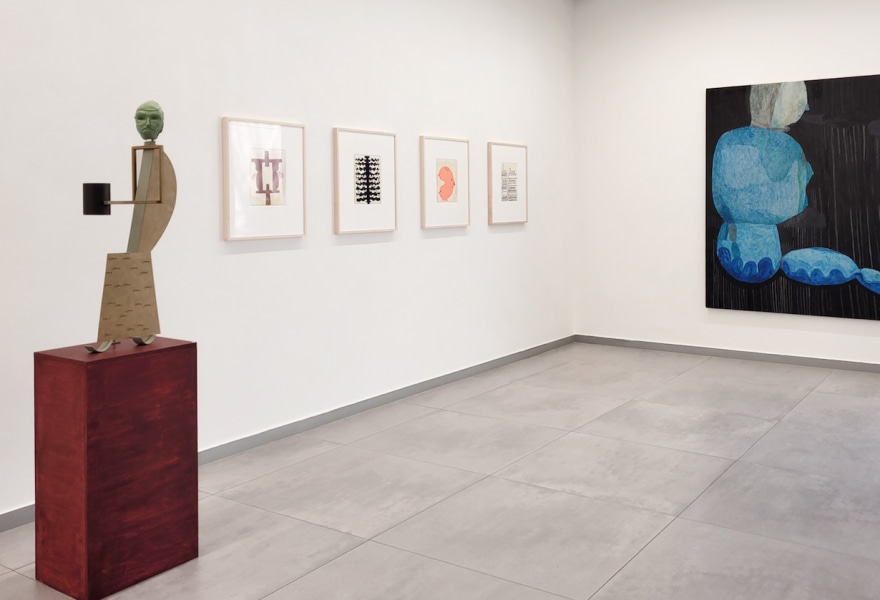03 march 2025, Wouter van den Eijkel
Great minds think alike
In 'Doppelmensch', Galerie Maurits van de Laar is presenting the work of two artists with much in common: Martin Assig and Dirk Zoete. Both combine simple geometric shapes with a naive yet powerful visual language. After 13 years, they have once again collaborated on an exhibition. “It’s a dream exhibition for both artists.”
Gallery owner Maurits van de Laar remembers as if it were yesterday. In the middle of the 1990s, he received a list of German artists participating in an exchange project by the Goethe Institute for Art Cologne. He was unimpressed by the work—until he reached the bottom of the list and saw Martin Assig's work. Van de Laar was immediately captivated by Assig’s ink drawings. “This is incredibly good,” he thought to himself.
Since then, Van de Laar has worked with Martin Assig. The German artist (b. 1959) gained international recognition for his work on paper, with a focus on fundamental aspects of human existence, such as relationships with others, the world, life and death. The gallery is now showcasing a new series of his ink drawings. “He wanted to return to the source,” explains Van de Laar about the series that Assig began in 2023.

Doppelmensch, Galerie Maurits van de Laar
The exhibition takes its title from one of the ink drawings. In the small piece, we see a Januskopf (a two-faced figure) above a black plane — a Doppelmensch. This refers to the artistic connection between Assig and Zoete. Great minds think alike — in this case, two heads that think in a similar way. Some of the work in the series depicts human bodies with the head extending beyond the edges of the drawing, showing only the legs and torso. Another recurring motif is a small house positioned on a thigh or integrated into a body.
There is also a drawing featuring four faces, each with a tail on either side. The composition consists of no more than four bowl-like shapes and two lines, yet the immediacy with which Assig communicates remains striking. “It is incredibly simple work,” says Van de Laar. “It is vulnerable, yet very strong. These drawings are highly physical, yet spiritual. For Assig, the body is a fragile house in which the soul resides.”
St. Paul
The exhibition also features several works from the "St. Paul" series, as well as recent pieces from the "Seelen" series. In St. Paul, Assig subtly references Paul Klee, who incorporated multiple styles and motifs into his work. Since starting this series in 2009, Assig has essentially created a sanctuary for himself, a space where he can reference other artists and his own work, alternating between concrete human figures and abstract patterns and forms.
This alternation between different forms and techniques is evident in the selection displayed at the gallery. At the back of the gallery is work in which, like Klee, Assig combines text and image. One example is a metaphorical street map with words that undermine the stability usually provided by a map. Assig’s map features street names like Planung (Planning), Zufall (Chance), Möglichkeit (Possibility), Denken (Thinking), Fühlen (Feeling) and Leben (Life).

Martin Assig, St. Paul #942, 2018, Galerie Maurits van de Laar
At the front of the gallery, six works from the same series are displayed, where text is almost absent and the creative process is different. These works are nearly transparent, resembling parchment. But this effect is not accidental — Assig uses an iron to rub wax onto the back of the paper, giving the pieces a beautifully saturated colour. Despite the differences, the work remains thematically connected to the ink drawings. In the piece "St. Paul #1069", we see a kneeling woman, a motif that appears frequently in Assig’s work.
Delayed reprise
Van de Laar first paired Assig and Dirk Zoete in an exhibition 13 years ago. Since then, the artists have admired each other's work and developed a friendship. 'Doppelmensch' can be seen as a delayed reprise. “It is a dream exhibition for both artists,” says Van de Laar.
When viewing the work together, their mutual admiration becomes evident. Both artists favour simple forms and have a naive yet direct visual language. Van de Laar compares Assig and Zoete’s work to that of outsider artists: “Their work borders on that of outsider artists. With outsiders, you sense there is no filter, that everything comes from a deeply personal, direct source. That is exactly what they are aiming for in their work. And that is what makes it so exciting.”
The exhibition includes etchings, drawings, works on paper and sculptures by West Flemish artist Dirk Zoete (Belgium, b. 1969). “Zoete shows you the world of a child perceived through the eyes of an adult.” This is a fitting comparison — for example, in the piece "Alma", we see a cellist composed of two semicircles and a few straight lines representing limbs and a bow. His drawings also lack depth, presenting only an outline.
Zoete’s visual language of circles, semicircles, straight lines and right angles also reappears in his sculptures. The geometric shapes in this work resemble distant relatives of Malevich’s Suprematist figures or Oscar Schlemmer’s Triadic Ballet costumes. But the masks of the statues hint that their origins may lie closer to home — in the folklore of procession giants.
On Friday evening, 7 March, Galerie Maurits van de Laar will take part in HOOGTIJ, The Hague’s art route featuring free guided tours through galleries and art institutions in the city. The starting point is West Den Haag at Lange Voorhout 102. Reservations can be made here.
